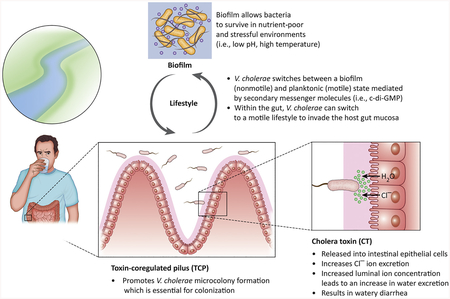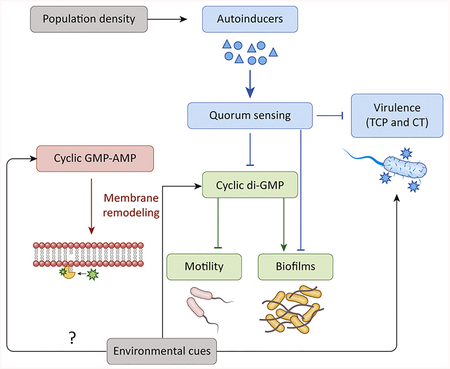
Vibrio cholerae is the bacterial pathogen responsible for the disease cholera, plaguing many developing nations and areas of poor sanitation, and causing about 2.9 million cases and ~95 000 deaths annually. It is transmitted through contaminated water and infects the host using two major virulence factors: the toxin-coregulated pilus (TCP) and cholera toxin (CT). TCP is important for colonization of the host gut mucosal layer where CT is released and passes through the gastroendothelial wall to cause watery diarrhea. Biofilm formation by V. cholerae provides protection and a means of transportation for the bacteria to colonize a wide range of environments such as humans and aquatic reservoirs. V. cholerae is used as a model organism to study virulence due to its high infectious dose, ease of genetic manipulation, and rapid replication time. It is also a model for studying chemical signaling such as cell-to-cell communication via quorum sensing and cyclic dinucleotide signaling.
KEY FACTS:
The current 7th pandemic is caused by the El Tor biotype, which has acquired a cyclic GMP–AMP (cGAMP) signaling system.
V. cholerae is a model organism to study due to the significant parallels with other Gram-negative bacteria, high infectious dose (103–108), and rapid replication time (17 min).
It is used as a model system for studying chemical signaling, including the transition between motility and biofilm formation controlled by cyclic-di-GMP (c-di-GMP).
DISEASE FACTS:
Transmitted through the fecal–oral route.
Recent pandemics in Haiti, Ethiopia, and Yemen.
Highest disease burden in sub-Saharan Africa. Low to nonexistent prevalence in developed nations.
Treatable with oral rehydration therapy (ORT); however, it is still largely a problem in settings of poor access to healthcare and sanitation.
An oral cholera vaccine is available in two doses with >85% protection for up to 6 months after the complete course with more efficacious vaccines being developed.

TAXONOMY AND CLASSIFICATION:
KINGDOM: Bacteria
PHYLUM: Proteobacteria
CLASS: Gammaproteobacteria
ORDER: Vibrionales
FAMILY: Vibrionaceae
GENUS: Vibrio
SPECIES: cholerae
Gram-negative, curved rod-shaped bacterium
Literature
- 1.Ali M et al. (2015) Updated global burden of cholera in endemic countries. PLoS Negl. Trop. Dis 9, 1–13 [DOI] [PMC free article] [PubMed] [Google Scholar]
- 2.Chen WH et al. (2016) Single-dose live oral cholera vaccine CVD 103-HgR protects against human experimental infection with Vibrio cholerae O1 El Tor. Clin. Infect. Dis 62, 1329–1335 [DOI] [PMC free article] [PubMed] [Google Scholar]
- 3.Hauck FR et al. (2009) Identification and management of latent tuberculosis infection. Am. Fam. Physician 79, 879–886 [PubMed] [Google Scholar]
- 4.Herrington DA et al. (1988) Toxin, toxin-coregulated pili, and the toxR regulon are essential for Vibrio cholerae pathogenesis in humans. J. Exp. Med 168, 0–5 [DOI] [PMC free article] [PubMed] [Google Scholar]
- 5.Koestler BJ and Waters CM (2014) Bile acids and bicarbonate inversely regulate intracellular cyclic di-GMP in Vibrio cholerae. Infect. Immun 82, 3002–3014 [DOI] [PMC free article] [PubMed] [Google Scholar]
- 6.Mekalanos JJ et al. (1983) Cholera toxin genes: nucleotide sequence, deletion analysis and vaccine development. Nature 306, 551. [DOI] [PubMed] [Google Scholar]
- 7.Nalin D et al. (1968) Oral maintenance therapy for cholera in adults. Lancet 292, 370–372 [DOI] [PubMed] [Google Scholar]
- 8.Soler-Bistué A et al. (2015) Genomic location of the major ribosomal protein gene locus determines Vibrio cholerae global growth and infectivity. PLoS Genet. 11, 1–21 [DOI] [PMC free article] [PubMed] [Google Scholar]
- 9.Wang Z et al. (2017) Immunity provided by an outer membrane vesicle cholera vaccine is due to O-antigenspecific antibodies inhibiting bacterial motility. Infect. Immun 85, 1–9 [DOI] [PMC free article] [PubMed] [Google Scholar]
- 10.Waters CM et al. (2008) Quorum sensing controls biofilm formation in Vibrio cholerae through modulation of cyclic di-GMP levels and repression of vpsT. J. Bacteriol 190, 2527–2536 [DOI] [PMC free article] [PubMed] [Google Scholar]


